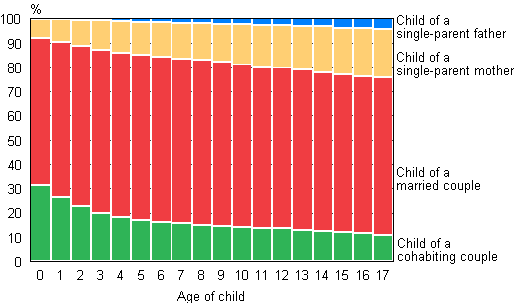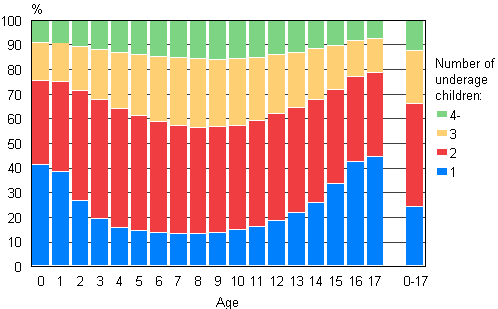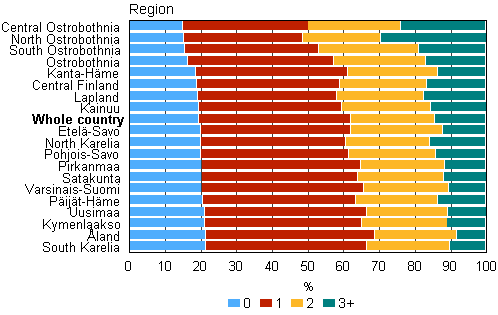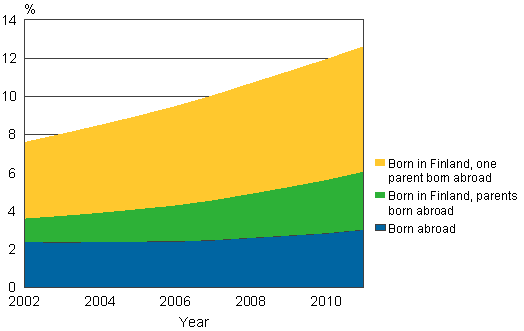5. Sixty-six per cent of children live in families of married couples
Families with children can also be examined by taking the child as the statistical unit instead of the family. Then the results are slightly different. For example, 61 per cent of the families with underage children are those of married couples, but 66 per cent of all children live in families of married couples, because these families have a higher average number of children than families of cohabiting couples or one-parent families. When the children of cohabiting couples and registered partnerships are included, 83 per cent of underage children live in two-parent families.
Table 8. Children aged under 18 by type of family in 1985–2011
| Year | Total | Married couple | Registered partnership | Cohabiting couple | Mother | Father |
| 1985 | 1 136 027 | 959 580 | .. | 61 386 | 102 413 | 12 648 |
| 1990 | 1 135 686 | 916 855 | .. | 91 164 | 113 184 | 14 483 |
| 1995 | 1 150 562 | 858 255 | .. | 125 222 | 148 706 | 18 379 |
| 2000 | 1 116 687 | 777 447 | .. | 156 411 | 162 544 | 20 285 |
| 2005 | 1 084 865 | 727 638 | 131 | 172 898 | 162 875 | 21 323 |
| 2006 | 1 080 728 | 721 911 | 183 | 175 516 | 161 834 | 21 284 |
| 2007 | 1 076 522 | 716 804 | 216 | 176 801 | 161 184 | 21 517 |
| 2008 | 1 071 800 | 713 202 | 277 | 175 986 | 160 730 | 21 605 |
| 2009 | 1 068 554 | 708 684 | 331 | 175 951 | 161 755 | 21 833 |
| 2009 | 1 068 554 | 708 684 | 331 | 175 951 | 161 755 | 21 833 |
| 2010 | 1 064 470 | 704 953 | 397 | 175 563 | 161 427 | 22 130 |
| 2011 | 1 061 710 | 701 396 | 500 | 175 981 | 161 575 | 22 258 |
| Per cent | ||||||
| 1985 | 100,0 | 84,5 | .. | 5,4 | 9,0 | 1,1 |
| 1990 | 100,0 | 80,7 | .. | 7,9 | 10,0 | 1,3 |
| 1995 | 100,0 | 74,6 | .. | 10,9 | 12,9 | 1,6 |
| 2000 | 100,0 | 69,6 | .. | 14,0 | 14,6 | 1,8 |
| 2005 | 100,0 | 67,1 | 0,0 | 15,9 | 15,0 | 2,0 |
| 2006 | 100,0 | 66,8 | 0,0 | 16,2 | 15,0 | 2,0 |
| 2007 | 100,0 | 66,6 | 0,0 | 16,4 | 15,0 | 2,0 |
| 2008 | 100,0 | 66,5 | 0,0 | 16,4 | 15,0 | 2,0 |
| 2009 | 100,0 | 66,3 | 0,0 | 16,5 | 15,1 | 2,0 |
| 2010 | 100,0 | 66,2 | 0,0 | 16,5 | 15,2 | 2,1 |
| 2011 | 100,0 | 66,1 | 0,0 | 16,6 | 15,2 | 2,1 |
Of all babies aged under one, 92 per cent live with both parents and eight per cent with a single mother (Figure 9). In eleven years, the first mentioned percentage has risen by only one percentage point while the latter has remained unchanged.
The share of children living with their father or mother rises with age. One-fifth of 17-year-old children live with the mother only; one decade ago the share was 17 per cent. Respectively, four per cent live with the father only, which is the same proportion as ten years earlier.
Figure 9. Children by type of family and age in 2011, relative breakdown

5.1 One-third of children live with at least two siblings
Although 44 per cent of families with children had only one child at the end of 2011, only 24 per cent of the children in these families had no siblings. The status of an only child is temporary for many of these children, as the majority of them will have a sibling later on. Some of these children may also have had an older sibling who has already turned 18 or moved away from home.
At the end of 2011, altogether 42 per cent of all children lived with one sibling and as many as 34 per cent of all children had at least two siblings living at home. In 1985, only 27 per cent of all children had at least two siblings at home.
Table 9. Children by number of underage children in the family in 1985–2011
| Year | Total | Number of underage children in families | |||
| 1 | 2 | 3 | 4- | ||
| 1985 | 1 136 027 | 306 784 | 518 206 | 221 211 | 89 826 |
| 1990 | 1 135 751 | 286 529 | 500 680 | 243 504 | 105 038 |
| 1995 | 1 150 562 | 284 915 | 484 092 | 257 283 | 124 272 |
| 2000 | 1 116 687 | 268 369 | 461 516 | 255 075 | 131 727 |
| 2005 | 1 084 865 | 255 549 | 451 758 | 245 325 | 132 233 |
| 2006 | 1 080 728 | 254 705 | 451 428 | 242 382 | 132 213 |
| 2007 | 1 076 522 | 254 832 | 450 088 | 238 782 | 132 820 |
| 2008 | 1 071 800 | 253 841 | 449 016 | 235 650 | 133 293 |
| 2009 | 1 068 554 | 254 457 | 447 554 | 232 584 | 133 959 |
| 2010 | 1 064 470 | 254 551 | 445 192 | 230 580 | 134 147 |
| 2011 | 1 061 710 | 253 995 | 443 286 | 229 101 | 135 328 |
| Per cent | |||||
| 1985 | 100,0 | 27,0 | 45,6 | 19,5 | 7,9 |
| 1990 | 100,0 | 25,2 | 44,1 | 21,4 | 9,2 |
| 1995 | 100,0 | 24,8 | 42,1 | 22,4 | 10,8 |
| 2000 | 100,0 | 24,0 | 41,3 | 22,8 | 11,8 |
| 2005 | 100,0 | 23,6 | 41,6 | 22,6 | 12,2 |
| 2006 | 100,0 | 23,6 | 41,8 | 22,4 | 12,2 |
| 2007 | 100,0 | 23,7 | 41,8 | 22,2 | 12,3 |
| 2008 | 100,0 | 23,7 | 41,9 | 22,0 | 12,4 |
| 2009 | 100,0 | 23,8 | 41,9 | 21,8 | 12,5 |
| 2010 | 100,0 | 23,9 | 41,8 | 21,7 | 12,6 |
| 2011 | 100,0 | 23,9 | 41,8 | 21,6 | 12,7 |
Figure 10 illustrates the cross-sectional nature of family statistics. It shows the ages of children in families by the number of children in the family. Here all children living at home and aged under 18 are taken into account when determining the status of an only child. Of the 0-year-olds, 41 per cent are without siblings, i.e. they are first-borns in their families. The proportion of children without siblings, 13 per cent, is the lowest for children aged 7 to 8.
A second child has most likely been born to a family at the latest by the time the first-born is aged around seven. On the other hand, the older sibling has only on rare occasions reached the age of 18. Since it can be assumed that some of the 7-year-old children will still have a sibling and some of them already have one who has left home, it can be concluded that some ten per cent of children will remain permanently without siblings. The same results are attained when looking at the number of children according to the number of children born to women in the whole country.
Figure 10 indicates that a child’s family is at its largest when he/she is aged between 8 and 9. In all, 44 per cent of children of that age live in families with three or more underage children. Their proportion is the same as in the previous year.
Figure 10. Children by age and number of children aged under 18 in the family in 2011

5.2 Lowest proportions of children without siblings in South Karelia and Åland
There are also differences in the numbers of siblings by area. In areas where families are bigger, the proportion of children living with several siblings is naturally larger than in areas of small families. In North and Central Ostrobothnia over 20 per cent of children have three or more siblings aged under 18 living at home. In contrast, the proportion of children living with more than three siblings is under ten per cent in Kymenlaakso, Uusimaa and South Karelia.
North and Central Ostrobothnia also have the lowest proportions of children living without siblings − under 20 per cent in both. More than every fourth child living in Kymenlaakso, Uusimaa, South Karelia and Åland has no siblings living at home.
Figure 11. Children by number of siblings by region in 2011, %

In Finnish municipalities Yli-Ii (9%), Luoto and Sievi (10%) have in relative terms the least children without siblings. In relative terms, the most children without siblings are living in Helsinki, Kolari and Pelkosenniemi (in all 31%).
The number of children of large families living with three or more siblings is in relative terms highest in Merijärvi (54%), Yli-Ii (52%) and Lumijoki (51%). In addition, over one half of children live in families with at least four children in Ranua, Perho and Sievi. The number of children living with at least three siblings is naturally in relative terms highest in municipalities that have the biggest sizes of families with underage children. In relative terms the lowest number of children are living with at least three siblings in Åland's Brändö and Sottunga where there are no families with four children. Next come Hammarland and Sund (4%). In Mainland Finland the number of children living with at least three siblings is lowest in Taivassalo (5%), Naantali and Ristijärvi (6%).
5.3 Seven per cent of children from reconstituted families
As in the previous year, 110,000 children (10% of all children) aged under 18 are raised in reconstituted families. Of them, 33,200 are the spouses' common children, that is, born to a family that previously had the mother’s and/or the father’s children only. Altogether 44 per cent of reconstituted families have had common children born to the family as well. There are 77,000 actual children of reconstituted families (7% of all children), that is, children who have obtained a new social parent. Of these children, 66,400 were brought into the family by their mother and 10,500 by their father.
5.4 Thirteen per cent of children of foreign background
Children's foreign background can also be viewed according to whether the children were self born abroad or their at least one parent was born abroad. By these criteria, the proportion of children with foreign background among all children is 13 per cent (137,000). It should be, however, remembered that part of children born abroad can be of Finnish background, such as children of Finnish-born parents working on a posting abroad. Here examined are all children in the population of Finland, also those who do not belong to the family population.
The proportion of children with foreign background has been growing steadily over the 2000s. At the end of 2002, eight per cent of all children were those who were born abroad or whose at least one parent was born abroad.
At the end of 2011, three per cent of children were born abroad, which is one percentage point more than in 2002. Children who were self born in Finland, but whose both parents were born abroad, also make up three per cent, while in 2002 this figure was one per cent.
As in 2002, in 2011 the number of children who were self born in Finland but whose one parent was born abroad was highest among children with foreign background (7%)
Figure 12. Share of children with foreign background among under 18-year-olds in 2002-2011

Source: Population and Cause of Death Statistics, Statistics Finland
Inquiries: Marjut Pietiläinen 09 1734 2798, Timo Nikander 09 1734 3250, vaesto.tilasto@stat.fi
Director in charge: Jari Tarkoma
Updated 9.11.2012
Official Statistics of Finland (OSF):
Families [e-publication].
ISSN=1798-3231. Annual Review 2011,
5. Sixty-six per cent of children live in families of married couples
. Helsinki: Statistics Finland [referred: 17.12.2025].
Access method: http://stat.fi/til/perh/2011/02/perh_2011_02_2012-11-09_kat_005_en.html

